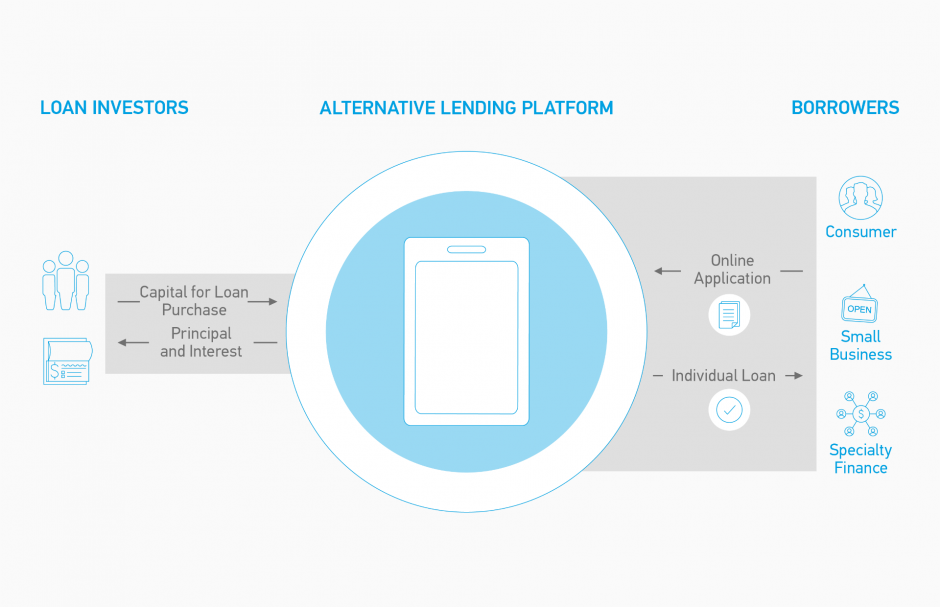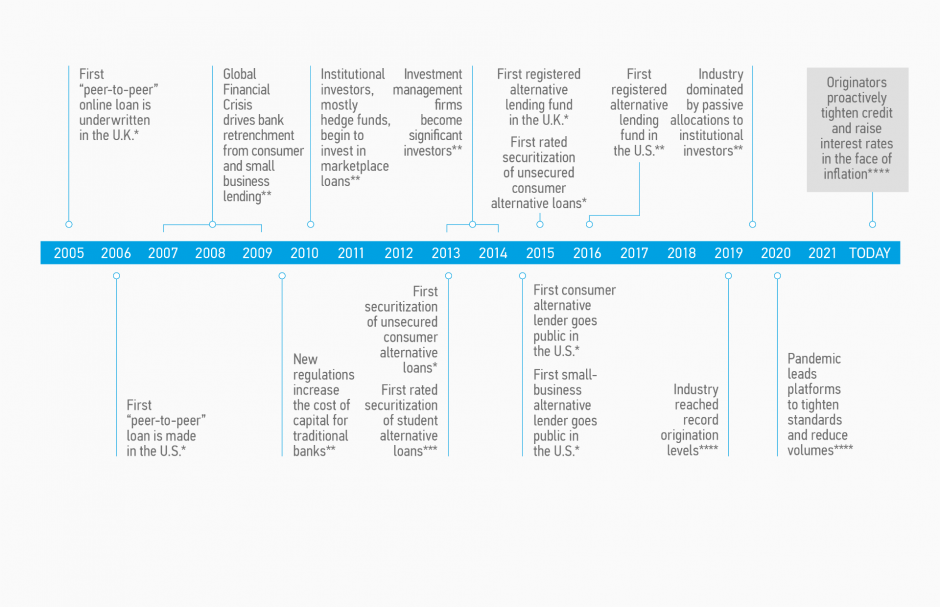
Morgan Stanley IM: An Introduction to Alternative Lending
As investors seek to diversify their portfolio exposures beyond traditional assets, alternative lending may offer attractive absolute and risk-adjusted return characteristics.
15.07.2022 | 09:02 Uhr
Here you can find the complete article.
An allocation to alternative lending may provide investors with exposure to a secular shift in the way consumers and small businesses access capital. In this paper, we provide insights on this asset class and discuss why we view it as a through-the-cycle allocation for well-balanced portfolios.
What Is Alternative Lending?
Alternately referred to as marketplace lending, peer-to-peer lending and P2P lending, alternative lending takes place through online platforms that use technology to bring together borrowers underserved by traditional lending institutions, with loan investors seeking attractive yield-generating investments. The lending model grew out of small-balance, peer-to-peer unsecured consumer loans financed by individual investors.
As the asset class matured, alternative lending evolved so that most loans are funded today by institutional investors, a group that counterintuitively includes even banks.1 Recognizing their technological and geographic constraints, community banks may focus on their core competency of deposit gathering while outsourcing credit underwriting and servicing to alternative lending platforms.
Credit risks underwritten by alternative lenders have expanded over time, beyond the unsecured consumer, to include small businesses, autos, commercial and residential real estate, receivables, student loans and other forms of specialty finance.
How Does it Work?
Consumer borrowers may seek alternative loans for a variety of reasons, including for debt consolidation or to pay down revolving credit card balances. By moving from a revolving structure to an amortizing installment structure, consumer borrowers may benefit from a lower interest rate than would be charged on a comparable revolving balance, such as from a credit card. Alternative lending platforms seek to streamline the traditional lending process by bringing borrowers and loan investors together, and by using technology-enabled models to rapidly underwrite borrower credit risk when determining appropriate loan pricing, terms and amounts offered to borrowers.
When borrowers accept loan offers, investors may purchase the loans post-issuance, for example, by actively selecting loans that they wish to purchase or by taking passive pro rata2 allocations of loans that meet prespecified criteria, considering loan type, size, term, duration, credit risk, geographic concentration, etc. Investors largely obtain the potential economic benefits and risks stemming from the loans, but the platforms typically maintain the customer relationship with end-borrowers and act as servicers for the loans, sending cash flows from the borrowers to the investors, net of servicing fees. The platforms also may charge loan origination fees, typically to the borrowers.
Platforms may use partner banks to formally originate the loans they underwrite. The partner banks typically conduct oversight on the platforms’ underwriting models and ensure that underwritten loans and servicing procedures comply with applicable laws. In some cases, the partner banks or platforms may maintain an economic interest in loans sold to investors.
The loans themselves generally have relatively low initial balances, and terms of three to five years are typical. Today the most common consumer unsecured alternative loan is fully amortizing, with a weighted average term3 of roughly 3.5 years and an average balance of roughly $10,043.4

The Evolution of Alternative Lending
Alternative lending grew rapidly in the decade following the first peer-to-peer online loans underwritten in the U.K. in 2005 and in the U.S. in 2006, gathering pace in the wake of the Global Financial Crisis.5 These small-volume credit experiments leveraged marketplace models alongside technology-enabled customer acquisition, underwriting and loan servicing geared to borrowers who had grown comfortable with online services. Alternative lending volumes scaled as the aftermath of the 2008 financial crisis drove bank retrenchment from consumer and small-business lending, and as new regulations increased the cost of capital for traditional banks, stressing the traditional banking model.
To facilitate burgeoning loan volumes, alternative lending platforms evolved their funding models from the original peer-to-peer format to institutional buyers serving as the predominant loan investors, purchasing portfolios of loans in bulk. Hedge funds were early buyers, actively selecting individual loans that they expected would outperform the platforms’ average underwriting. As the platform underwriting models matured and the opportunities for hedge fund alpha6 generation declined, institutional buyers largely migrated to passive pro rata purchases of loans within each buyer’s defined credit box.
Passive pro rata allocations moved the due diligence focus for loan purchasers from individual, small-balance loans to all the loans underwritten by a platform within a purchaser’s defined credit box, as well as to the platforms themselves. Passive allocations also facilitated deeper integration with the capital markets. The first securitization backed by unsecured consumer alternative loans occurred in 2013, and the first rated securitization of those loans followed in 2015. U.S. consumer and small-business alternative lending platforms first listed their shares publicly in 2014. The first registered alternative lending fund launched in the U.S. in 2016. In 2021, Morgan Stanley Research estimated nearly $15.3 billion of asset-backed security issuance by the marketplace lending sector. Issuance increased materially as compared to FY 2020 volume of approximately $10 billion.7 YTD 2022 through April, asset-backed security issuance by the marketplace lending sector totaled approximately $3.7 billion, outpacing 2021 YTD issuance for the same time period.8

* “The Hourglass Effect: A Decade of Displacement,” QED Investors, Frank Rotman, April 13, 2015; AIP Alternative Lending Group research.
** AIP Alternative Lending Group. The statements above reflect the opinions and views of AIP Alternative Lending Group as of the date hereof and not as of any future date and will not be updated or supplemented.
*** https://www.sofi.com/press/sofi-completes-251mm-sp-rated-securitization-refinanced-student-loans/
**** Source: dv01 Insights - Covid-19 Loan Origination Report Volume 13. June 1, 2022.
Why Is the Opportunity Compelling Today?
In our view, there are four main reasons why alternative lending may be a compelling strategy for investors:
- Alternative lending may provide a potential combination of attractive yield and low duration that stands in sharp contrast to the traditional fixed income universe. Alternative lending’s relatively low duration may reduce sensitivity to changes in benchmark interest rates. One contributor to low duration is the amortizing structure typical of alternative loans, which may facilitate vintage diversification9 that may be challenging to achieve with traditional fixed income that only repays principal at maturity. Furthermore, alternative lending may offer outsized credit spreads,10 gross of any defaults and recoveries. While alternative loans often are unsecured, meaning, defaults typically will be higher and recoveries lower than with traditional fixed income, we believe that alternative lending’s outsized credit spreads may provide a cushion against realized principal loss when investors encounter adverse economic environments, such as those caused by the COVID-19 pandemic or experienced during the Global Financial Crisis.
- Unsecured consumer alternative lending may be diversifying versus other major asset classes, including traditional corporate credit. Alternative lending’s underlying credit exposure often stems from the consumer, rather than from corporate or government credit exposure that generally dominates traditional fixed income allocations.
- Unsecured consumer alternative lending exhibited fundamental resilience through the COVID crisis. In response to COVID-induced economic shutdowns, alternative lending platforms tightened credit standards, decreasing underwriting volumes and increasing borrower selectivity, and they increased borrower interest rates. They also offered short-term loan modification programs to impacted borrowers, which likely reduced borrower defaults as the economic backdrop stabilized.
- Alternative lending reflects a diversified opportunity set. Indeed, the volume and variety of strategies have flourished in recent years, providing multiple axes for diversification (e.g., by loan segment, credit quality, geography, security interest, balance size and/or loan duration).

Conclusion
While ramping inflation is negatively impacting U.S. consumer confidence, we believe that alternative lending’s modest duration may limit direct interest rate sensitivity should the Fed continue to hike interest rates as significantly as market participants expect. As a primarily consumer-focused private credit opportunity, we believe that alternative lending can diversify investor’s traditional and private corporate credit allocations. Alternative lending’s yield, duration, and amortization characteristics continue to stand in stark contrast to most corporate debt. For these and other reasons, we believe that alternative lending can play an important role in investors’ portfolios through the cycle.




Diesen Beitrag teilen: